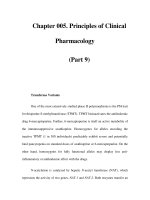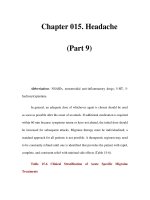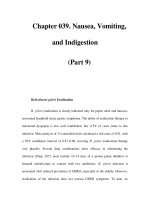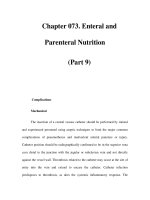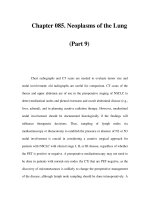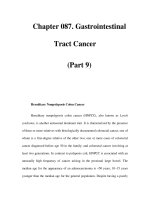Neurology 4 mrcp questions book - part 9 pps
Bạn đang xem bản rút gọn của tài liệu. Xem và tải ngay bản đầy đủ của tài liệu tại đây (25.08 KB, 14 trang )
2- Usually presents with fever, myalgia, and pharyngitis.
3- Renal and hepatic failures are seen.
4- The mortality rate may reach 50%.
5- No drug therapy against it can be used till now.
Q8: Yellow fever, all of the followings are wrong, except:
1- Caused by an RNA togavirus infection transmitted from cows through fleas feces.
2- Fortunately has a long incubation period of 3-6 months.
3- There may be an intense neutrophil leukocytosis and even a leukemoid reaction.
4- The usual presentation is with fever, join pain, muscle pain, and headache.
5- Excellent response to lamivudine.
Answer: 4
1- from monkeys through mosquitoes.
2- 3-6 days.
3- leukopenia is seen.
4- true, but not a specific picture.
5- false, no specific treatment, only supportive.
Q9: Dengue, all of the followings true, except:
1- A mosquito born infection.
2- There is fever, lymph node enlargement, and skin rash.
3- All individuals in endemic areas should be vaccinated.
4- Intense headache and backache.
5- Has an incubation period of 5-6 days.
Q10: Q fever, all of the followings are true, except:
1- There may be a history of exposure to animals.
2- May present as an atypical pneumonia.
3- One of the causes of culture negative infective endocarditis.
4- Poor response to tetracycline.
5- Liver dysfunction is seen.
Q11: Typhus fevers in general, all of the followings are true, except:
1- Are arthropod born infection.
2- The rickettsia infects and damages the endothelium of small blood vessels.
3- The mortality is variable and depends on the infecting agent.
4- All have gastroenteritis as a common prominent feature.
5- The treatment of choice is tetracycline.
Q12: Lyme disease, all of the followings are true, except:
1- History of a tick bite may not always be found.
2- The characteristic early skin rash may be not seen.
3- Cranial nerve palsies especially the facial nerve are seen.
4- Caused by spirochetes.
5- Joint involvement usually occurs in the form peripheral symmetrical small joint
arthropathy.
Q13: Secondary syphilis, all of the followings are true, except:
1- The rash is non itchy and characteristically spares the face.
2- Lymphocytic meningitis is seen and usually self limiting or asymptomatic.
3- VDRL is always positive.
4- Snail tract mucosal ulcerations are characteristic.
5- Even if not treated, not all patients will develop tertiary phase in the future.
Q14: Paratyphoid fever when compared with typhoid fever, all of the followings
are true, except:
1- Has shorter incubation period.
2- Usually presents with acute onset of vomiting and diarrhea.
3- The skin rash is much more prominent and common.
4- Less frequent intestinal complications.
5- Higher incidence of chronic carrier state.
Q15: Cholera, all of the followings are true, except:
1- May cause death even before the diarrhea appears.
2- Usually occurs in epidemics.
3- The organism is motile.
4- Tetracycline is used to shorten the duration of shedding of the organism in stool.
5- Severe abdominal pain that may be confused with acute abdomen.
Q16: Genital ulcers are caused by all but one of the followings, except:
1- Certain chlamydia strains infection.
2- Secondary syphilis.
3- Genital herpes infection.
4- Certain hemophillus strains infections.
5- Donavania granulomatis infection.
Q17: Gonorrhea, all of the followings are true, except:
1- Short incubation period of 2-5 days.
2- Purulent uretheral discharge and dysuria are the main features.
3- Needs tetracycline therapy for at least 20 days.
4- Females tend to be more asymptomatic than males.
5- Recurrences and re-infections are common.
Q18: Chemoprophylaxis is used in preventing many infectious disease, all of the
followings are true, except:
1- Rifampicine is useful in hemophillus infection prophylaxis in close contacts.
2- Rifimpicine is useful in meningococcal infection prophylaxis in close contacts.
3- Erythromycine is useful in Legionares disease prophylaxis in close contacts.
4- Erythromycine is useful in diphtheria prophylaxis in close contacts.
5- Ampicilline is useful in infective endocarditis prophylaxis in high risk group before
dental surgery.
Q19: HIV, all of the followings are true, except:
1- ENV viral gene encodes for the envelope proteins which are important for the
attachment and entry of the virus into cells.
2- Tuberculosis chest infection is much more common than pneumocyctis carinii
infection in Africans.
3- AIDS dementia complex may be a presenting feature.
4- Cryptosoridium diarrhea can prove fatal in AIDS patients.
5- Kaposi sarcoma of the GIT is usually gravely symptomatic.
Q20: Anti HIV medications, all of the followings are true, except:
1- Zidovudin can cause ragged red fibers on muscle biopsy.
2- Zalcitabine can cause esophageal ulceration.
3- Lipodystrophy is seen with protease inhibitors.
4- Non-nucleoside reverse transcriptase inhibitors can cause severe skin rashes.
5- Nail pigmentation is characteristically seen with squanavir.
Q21: Poor prognostic factors in Pneumocystis carinii pneumonia (PCP) in HIV
positive patients; all of the followings are true, except:
1- If occurs in a patient on no PCP prophylaxis.
2- High serum LDH.
3- High hypoxemia ratio.
4- Extensive chest radiographic changes.
5- A pre-existent chest infection.
Q22: HIV patients are having a greater risk than the normal population of all of
the followings, except:
1- Of reactivating a latent infection.
2- Of acquiring TB from an open contact.
3- Of developing a progressive primary disease.
4- Of developing an extra-pulmonary TB.
5- Of developing a mild CNS TB infection.
Q23: The atypical chest x ray appearances of Pneumocystis carinii pneumonia in
HIV patients include all of the followings, except:
1- Bilateral perihilar ground glass infiltrates.
2- Upper lobe infiltrates.
3- Unilateral involvement.
4- Lobar cavitations.
5- Focal consolidation.
Q24: CMV retinitis in HIV infected patients, all of the followings are true,
except:
1- There is a 90% fall in its incidence after the introduction of HAART.
2- 30% of patients have a bilateral disease at presentation.
3- Should be differentiated from acute retinal necrosis syndrome.
4- Vision will improve gradually in almost all cases.
5- Macular disease is rare.
Q25: Cryptosporidium diarrhea in HIV infected patients, all of the followings
are true, except:
1- Responsible for 20% of the causes of diarrhea in those patients.
2- It becomes chronic when the CD4 count is below 200/mm3.
3- Can cause malabsorption.
4- Immuno-fluorescence stains can detect the organism in stool.
5- May respond to interferon alpha.
Q26: Mycobacterium avium intracellulare infections in HIV positive patients, all
of the followings are true, except:
1- It is an environmental organism found in food and water.
2- All organs can be affected by a heavy infiltration of the organism.
3- Anemia and raised alkaline phosphatases are very commonly found.
4- Hepatosplenomegally are against the diagnosis.
5- Can be diagnosed by a positive blood culture.
Q27: Filariasis, all of the followings are true, except:
1- Can cause a very high eosinophil count.
2- Microfilariae survie for 2-3 days only.
3- W. bancrofti is transmitted through a bite of Culex mosquito.
4- Calabar swelling is seen in Loasis.
5- Onchocerciasis produces a severe visual impairment.
Q28: Tropical infections not associated with esosinophilia include all of the
followings, except:
1- Malaria.
2- Trypanosomiasis.
3- Leishmaniasis.
4- Giardiasis.
5- Ascariasis.
Q29: Tropical infections that are associated with eosinophilia include all of the
followings, except:
1- Toxocariais.
2- Cysticercosis.
3- Strongyloidiasis.
4- Trypanosomiasis.
5- Schistosomiasis.
Q30: The following infections correctly match their corresponding finding,
except:
1- Onchocerciasis- diffuse dermatitis.
2- Fascioliasis- urticarial skin rashes.
3- Strogyloidiasis- meningitis.
4- Trichinosis- myositis.
5- Cysticercosis- malabsorption.
Q31: Infective skin lesions in the tropics, all of the followings are true, except:
1- Myiasis can cause subcutaneous swellings.
2- Burruli ulcer is caused by mycobacterium ulcerans infection.
3- Larva currens is caused by strongyloidiasis.
4- Oreintal sore is caused by treponema infection.
5- Calabar swellings is caused by loa loa.
Q32: During the 1
st
month following solid organ transplantation; the following
infections are common, except:
1- Herpes simplex.
2- Wound infections.
3- Pneumonias.
4- Cather-related bacteremia.
5- Nocardia brain abscess.
Q33: During the 2
nd
to 6
th
months following solid organ transplantation; the
following infections are common, except:
1- Listeria monocytogenes.
2- CMV.
3- Aspergillus.
4- Cryptococcus.
5- Staph aureus
Q34: All of the following infections are associated with the presence of fecal
leukocytes on stool examiantion, except:
1- Cholera.
2- Shigella.
3- Salmonella enteritidis.
4- Compylobacter jejuni.
5- Vibrio parahemolyticus.
Q35: Which one of the following organism is the cause of Chagoma?
1- Toxoplassma gondii.
2- Leishmania donavani.
3- Hemophilus species.
4- Trypanosoma cruzi.
5- JC virus.
Q36: Those who have cats at home are more liable for certain cat related
infections that the general poulation, all of the following infections are true,
except:
1- Toxacariasis.
2- Toxoplasmosis.
3- Strogyloidiasis.
4- Dermatomycosis.
5- Skin candidiasis.
Q37: All of the followings are the cause of a biologic chronic false positive Rapid
Plasma Reagent (RPR) testing, except:
1- Systemic lupus erythematosus.
2- Lepromatous leprosy.
3- Intravenous drug addicts.
4- Pregnancy.
5- Rheumatoid arthritis.
Q38: The following can cause a positive monospot test, except:
1- Hepatitis viruses.
2- Lymphoma.
3- Serum sickness.
4- Infectious mononucleosis.
5- Streptococcus skin infections.
Q39: Lock jaw is classically seen in tetanus; all of the followings can cause low
jaw and trismus, except:
1- Pheothiazines.
2- Sarcoma of the jaw.
3- Strychnine poisoning.
4- Guillain Barre syndrome.
5- Ludwig's angina.
Q40: In which sexually transmitted disease does the "groove sign" appear:
1- Lymphogranuloma venereum.
2- Granuloma inguinale.
3- Secondary syphilis.
4- Gonorrhoea.
5- Herpes simplex type I infection.
End of Infectious disease…
Chapter XIII / Immunology
Q1: Immunoglobulins, all of the followings are true, except:
1- IgA is mainly found in body fluids
2- IgM is a high molecular weight immunoglobulin that is the largest of all
immunoglobulins.
3- IgG is the only one that passes the placental barrier.
4- IgE is involved in Type IV hypersensitivity reactions.
5- IgD is found on the surface of B cells and may be involved in the maturation of
them.
Q2: Immunoglobulins, all of the followings are true, except:
1- IgA may cause hyperviscosity in multiple myeloma.
2- IgE is very high in allergic bronchopulmonary aspergillosis.
3- IgG is the usual immunoglobulin detected as a rheumatoid factor by the slide
agglutination test.
4- Selective IgA deficiency prevalence is 1/700 of the general population.
5- Anti-nuclear factor is usually an IgG autoantibody.
Q3: The complement system, all of the followings are true, except:
1- The classical pathway can be activated by IgG immune complexes.
2- Properdin deficiency is usually X linked.
3- Deficiency of late complement components is associated with disseminated
Niesseria infection.
4- SLE may be induced by congenital deficiency of the early complements
components.
5- C1 esterase inhibitor deficiency is autosomal dominant and the defect is qualitative
in 90% of cases.
Q4: Hypogammaglubuinemia is associated with all of the followings, except:
1- Thymoma.
2- Phenytoin treatment.
3- Myotonia dystrophica.
4- Protein losing enteropathy.
5- Chronic active hepatitis.
Q5:In common variable immune deficiency (CVID), all of the followings are
true, except:
1- 30% of cases have an associated lymphopenia and lymphadenopathy.
2- IgA is virtually absent, but IgG is usually severely decreased but still
detectable.
3- Although defective cell mediated immunity is documented but opportunistic
infections due to this defect is rare in clinical practice.
4- In theory the presentation may be at any age ,but usually in the 3
rd
decade.
5- First degree relatives are at increased risk of IgG subclass deficiency.
Q6: Long term complications of hypogammaglobulinemia, all of the followings
are true, except:
1- Induction of varieties of autoimmune diseases.
2- High risk of lymphoreticular malignancies.
3- Bronchiectasis.
4- Malabsorption.
5- Chronic active hepatitis.
Q7: X linked agammaglobulinemia, all of the followings are true, except;
1- T cell number and function are normal.
2- There are no mature B cells in the peripheral blood.
3- IgG is usually still detectable but extremely low.
4- The presentation is usually after 3-6 months after birth.
5- It is a very common disease.
Q8: Selective IgA deficiency, all of the followings are true, except:
1- Its incidence is 1/700 of the general population and usually sporadic.
2- In theory, checking serum IgA level should be done in all patients prior to truncal
vagotomy.
3- All suspected patients should be tested for IgA auto-antibodies.
4- It is seen in 50% of celiac disease patients.
5- Can be found in patients with rheumatoid arthritis.
Q9: In HIV infection, all of the followings are true, except:
1- There are M-tropic and T tropic strains.
2- There is polyclonal B cell activation.
3- NK cell number and function are usually impaired.
4- There is no single mechanism to explain the progressive CD4 positive cells
attrition over time.
5- The macrophages are CD4 negative cells and hence protected from infection.
Q10: The major histocompatibility complex (MHC) and human leukocyte
antigen (HLA), all of the followings are true, except:
1- MHC class II antigen is restricted in distribution to certain cell types.
2- The inheritance is autosomal co-dominant
3- The loci encoding the complement components are located near by at chromosome
number 6.
4- Certain HLA haplotypes are associated with varieties of autoimmune diseases.
5- HLA DR2 confers a high risk of developing type I diabetes mellitus.
End of immunology…
Chapter XIV / Psychiatry
Q1: The followings, except one, are consistent with acute confusional state rather
than dementia in evaluating a patient with abnormal cognition:
1- Fluctuated level of consciousness.
2- Rapid development.
3- Visual hallucination.
4- The presence of fever.
5- Gradual loss of short term memory over time.
Q2: Anorexia nervosa, all of the followings are true, except:
1- The blood levels of prolactin, cholesterol, and glucagons are raised.
2- Bradycardia and hypotension are found.
3- Prominent sexual and physical retardation.
4- Amenorrhea is usually present for more than 3 months.
5- Usually starts around adolescence.
Q3: Which one of the followings is true regarding Bulimia Nervosa?
1- Weight loss is prominent.
2- Usually starts around puberty.
3- Hospital admission is required to treat it.
4- Loss of self control and binge eating behavior is present.
5- Grossly disorganized perception of body image and weight.
Q4: Good prognostic factors in schizophrenia, all of the followings are true,
except:
1- Acute onset of true disorder.
2- Good job records.
3- The presence of a clear cut precipitating event.
4- Normal premorbid personality.
5- Absence of affective symptoms.
Q5: In depression, all of the followings are true, except:
1- The presence of low self esteem is prominent.
2- Some patients lose weight.
3- Loss of pleasure and loss of libido.
4- Presence of irritability is against the diagnosis.
5- Some patients have early insomnia.
Q6: Antipsychotic drugs, all of the followings are true, except:
1- The newer generation like olanzapin is more effective at the negative symptoms of
schizophrenia.
2- In general, no one drug is superior in efficacy over the others.
3- Extrapyramidal features are uncommon in those antipsychotics with prominent
anticholinergic side effects like thioridazine.
4- May be used in the control of acute mania.
5- Some of them may be used in the control of nocturnal enuresis.
Q7: Tricyclic antidepressants, all are true except
1- Mainly inhibit the reuptake of noradrenalin and serotonin at receptor sites in the
brain.
2- Should be used with caution in elderly people as they may cause cardiac toxicity.
3- May cause postural hypotension.
4- Their effect is usually seen after 2-4 weeks, some times up to 6 weeks.
5- Are the first line agents in severe depression with attempted suicide.
Q8: Alcohol abuse is suspected in all but one of the followings?
1- Unexplained atrial fibrillation.
2- Unexplained hypertension.
3- Unexplained diarrhea.
4- Unexplained gout in pre-menopausal female.
5- Unexplained papulomacular skin rash.
Q9: The risk of a success after an attempted suicide is increased in the
followings, except:
1- Being a young female rather than a male.
2- Living alone.
3- Presence of a malignant disease.
4- Using a gun rather than self poisoning.
5- Being divorced rather than happily married.
Q10: All of the followings are indications for electro-convulsive therapy in
depression, except:
1- Severe depression with a failed suicidal attempt using a gun.
2- Severe depression interfering with daily eating causing nutritional problems.
3- Mildly depressed patient intolerant to the oral tricyclics.
4- Severe depression with prominent psychotic symptoms.
5- Agitated depression.
End of Psychiatry…
Chapter XV / Dermatology
Q1: Psoriasis, all of the followings are true, except:
1- The disease may be exacerbated by lithium and propranolol treatment.
2- Psoriatic arthritis should not be treated by chloroquin.
3- Some areas of involvement may be hidden and we have to carefully examine these
areas.
4- Guttate type is seen predominantly in middle aged people.
5- The inheritance is polygenic.
Q2: Treatment of psoriasis, all of the followings are true, except:
1- Dithranol can very effective in psoriatic plaques on the face and genitals.
2- Topical vitamin D analogues have been shown to be effective.
3- Flexural psoriasis can be treated with topical steroids combined with topical
antifungal preparations.
4- Topical steroid creams when being withdrawn gradually it is advisable to combine
them with topical tar preparations.
5- Methotrexate has an advantage of targeting both the skin and join disease.
Q3: All but one of the followings can induce the appearance of acneform rash:
1- Systemic steroids.
2- Androgenic steroids.
3- Lithium carbonate.
4- Phenytoin.
5- Isotretinoin.
Q4: Rosacea , all of the followings are wrong, except :
1- Usually seen in adolescents.
2- Prominent white and black comedons are present.
3- Unfortunately there is a poor response to tetracyclines.
4- Facial telangiectasias and erythema are rarely seen.
5- Conjunctivitis and keratitis are seen.
Q5: Lichen planus, all of the followings are true, except:
1- Can produce a scarring alopecia.
2- Mouth mucosal involvement is common but frank mucosal ulceration is rare.
3- The absence of itching is against the diagnosis.
4- The disease is disabling and persists for life with relapses and remissions.
5- Nail changes are seen.
Q6: Causes or pruritis, all of the followings are true, except:
1- Oral contraceptive pills.
2- Iron deficiency anemia.
3- Chronic renal failure.
4- Pregnancy.
5- Treatment with rifampicin.
Q7: Intense disabling itching is characteristically seen in all but one of the
followings:
1- Scabies.
2- Lichen planus.
3- Dermatitis herpetiformis.
4- Atopic eczema.
5- Vitiligo.
Q8: Nail examination can be very helpful in providing a clue to many diseases,
all of the followings are true, except:
1- Blue nail lunulae may indicate Wilson's disease.
2- Beua's lines may indicate a serious disease in the past 2-3 months.
3- Koilonychia indicates severe long standing iron deficiency anemia.
4- Diffuse symmetrical black nails may indicate a severe chronic liver disease.
5- Half and half nails are seen in chronic renal failure.
Q9: In HIV, the following skin diseases are seen, except:
1- Seborrhoeic dermatitis is much more common that control subjects.
2- Drug induced skin rashes are very common and may limit many medications
usage.
3- Wide spread purple spots and plaques may indicate Kaposi sarcoma.
4- Impetigo is very commonly seen and is of the AIDS defining illnesses.
5- Repeated unexplained oral candidiasis may be the first clue.
Q10: Basal cell carcinoma of the skin, all of the followings are true, except:
1- Mainly seen in old people.
2- Unfortunately metastasizes early to the lungs.
3- May be an ulcer with rolled up edges with fine telangiectasia.
4- Best treated by surgery.
5- Mainly seen on the face.
Q11: Risk factors for malignant melanomas, all of the followings are true,
except:
1- Ultra violet radiation exposure.
2- Fair skin.
3- Positive family of malignant melanoma.
4- Atypical melanocytic naevi.
5- Diabetes mellitus.
Q12: Malignant melanoma of the skin; all of the followings are true, except:
1- Two thirds of invasive cases are preceded by a superficial and radial growth phase.
2- Lentigo maligana and lentigo maligna melanoma are seen mainly in the legs of
young people.
3- Superficial spreading melanoma is the commonest subtype.
4- 30-50% of malignant melanomas appear to be derived from a pre-existent
melanocytic nevus.
5. non pigmented melanomas are seen.
Q13: Regarding the prognosis of malignant melanoma; which one is the correct
statement?
1- Men generally fare better than women.
2- Tumors of the legs are generally less aggressive.
3- The Breslow's tumor thickness is useful predicting the prognosis in stage III of the
disease.
4- Those with stage I disease have a 5 year survival rate of 5%.
5- Those with Breslow tumor thickness of less than 1 mm have a very good prognosis.
Q14: Risk factors for squamous cell carcinoma of the skin, all of the followings
are true, except:
1- Long term immune suppressive therapy in solid organ transplantation.
2- Dystrophic epidermolysis bullosa.
3- Chronic cutaneous ulceration.
4- Dark skin.
5- Over treatment with PUVA therapy for long time.
Q15: Regarding skin tumors and their precursors in general, all of the followings
are wrong, except:
1- Seborrhoeic warts are malignant tumors that are seen mainly in young people.
2- Actinic keratosis lesions are having a full thickness dysplasia in the skin.
3- Bowen's disease is due to partial thickness dysplastic changes in the hypodermis.
4- On histological examination, a keratoacanthoma may resemble a squamous cell
carcinoma.
5- Seborroeic warts are tumors of the sebaceous skin glands.
Q16: Nail disorders are commonly misdiagnosed in clinical practice; all of the
followings are true, except:
1- The presence of a ladder pattern of transverse ridges in the thumb may indicate a
habit-tic dystrophy.
2- With an absent history of nail trauma, a subungual hematoma might be mistaken
for a subungual malignant melanoma.
3- Splinter hemorrhages can be seen in psoriatic nails.
4- The presence of shiny polished nails in chronic atopic dermatitis is against the
diagnosis.
5- A yellow brown discoloration with crumbling of the nail plate is seen in fungal nail
infection.
Q17: Skin manifestations of sarcoidosis, all of the followings are true, except:
1- Dusky red painful and tender nodules on the shin.
2- Infiltration of long standing skin scars.
3- Purplish plaques on the nose.
4- Hypopigmented papules.
5- Erythroderma.
Q18: Causes of erythema multiforme, all of the followings are true, except:
1- Mycoplasma infections.
2- Barbiturates
3- Treatment of internal malignancies with radiotherapy.
4- Human herpes virus type 8 infection.
5- Orf.
Q19: Pyoderma gangrenosum, all of the followings are true, except:
1- In 50% of cases, no cause can be identified for its development.
2- Skin biopsy is greatly helpful in the diagnosis.
3- Can be a recurrent event.
4- May respond to minocycline.
5- Local infections should be treated aggressively.
Q20: The followings are the skin manifestations of porphyria cutanea tarda,
except:
1- Excessive skin fraglity.
2- Small skin erosions.
3- Milias.
4- Diffuse skin hypopigmentation.
5- Facial hypertrichosis.
Q21: Causes of generalized skin hyperpigmentation, all of the followings are
true, except:
1- Nelson's syndrome.
2- Primary biliary cirrhosis.
3- Chronic renal failure.
4- Phneylketonuria.
5- Addison's disease.
Q22: The followings might cause a flare up of psoriasis, except:
1- A medication given to treat systemic hypertension.
2- A medication given to a bipolar patient.
3- A prophylactic medication given to someone traveling to the central Africa.
4- Skin surgery to remove a small benign nevus.
5- A medication given to treat an acute attack of asthma.
Q23: general principles in the treatment of eczemas, all of the followings are
true, except:
1- Explanation and reassurance and encouragement of the patient.
2- Avoidance of contacts with ittitants.
3- Regular use of greasy emollients.
4- Appropriate use of topical steroids
5- Regular use of cyclosporine.
Q24: Drug induced hirsutism in women, all of the followings can be a cause,
except:
1- Pheytoin.
2- Cyclosporine.
3- Minoxidil.
4- Androgens.
5- Oral contraceptive pills.
Q25: Investigations used in eczema in general, all of the followings are true,
except:
1- Patch test.
2- Total and specific IgE blood level.
3- Prick skin testing.
4- Bacteriology swab from the skin lesion.
